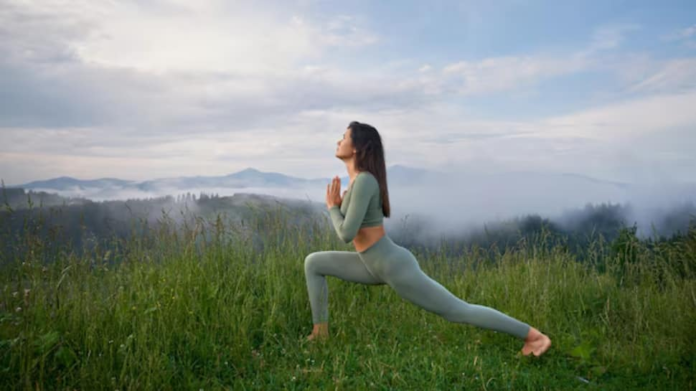In today’s fast-paced digital world, finding time to reconnect with nature and tune into your inner peace can be a powerful act of self-care. Practicing yoga in natural surroundings not only grounds your body but also harmonizes your mind and soul with the rhythms of the Earth.
Here are five deeply calming yoga asanas that help you build that connection with nature and elevate your inner peace:-
1. Tadasana (Mountain Pose)
Symbolism: Represents stability, strength, and grounding.
Tadasana is a foundational pose that encourages stillness and awareness, just like a mountain. When practiced outdoors — barefoot on grass or earth — it enhances your connection with the ground, helping you feel rooted and present.
How to Practice:
Stand tall with feet together, arms by your sides.
Distribute weight evenly across both feet.
Inhale deeply, lengthen your spine, and reach your arms upward.
Keep your gaze forward and breathe mindfully.
Benefits:
Improves posture
Enhances body awareness
Grounds your energy and calms the nervous system
Best practiced at sunrise for a refreshing start to the day.
2. Vrikshasana (Tree Pose)
Symbolism: Reflects balance, growth, and harmony with nature.
This pose mirrors the grace and strength of a tree, teaching balance and focus. Practicing Vrikshasana while facing a tree or being surrounded by greenery enhances your awareness of your own place in the ecosystem.
How to Practice:
Stand tall and shift weight onto one leg.
Place the sole of the other foot on your thigh (avoid the knee).
Bring your palms together in prayer at your heart or overhead.
Maintain balance while breathing slowly.
Benefits:
Improves concentration
Strengthens legs and core
Cultivates calmness and inner clarity
Try this under a tree for an immersive experience.
3. Bhujangasana (Cobra Pose)
Symbolism: Represents awakening and transformation.
Bhujangasana, when performed on natural earth, feels like a symbolic rising of energy — like the sun peeking over the horizon. It opens your heart and connects you with the life force around and within you.
How to Practice:
Lie face-down with palms under shoulders.
Inhale and lift your chest off the ground using your back muscles.
Keep elbows slightly bent and shoulders relaxed.
Benefits:
Opens the chest and lungs
Invigorates the spine
Encourages emotional release
Perfect for early morning practice facing the sun.
4. Padmasana (Lotus Pose)
Symbolism: Symbol of spiritual growth and inner purity.
Padmasana is one of the most meditative postures that encourages stillness and connection with your breath. Practicing it in a garden or by a lake enhances your sense of serenity and spiritual oneness.
How to Practice:
Sit on the ground with legs crossed, each foot placed on the opposite thigh.
Rest hands on knees in a mudra (like Chin Mudra).
Keep spine straight and shoulders relaxed.
Benefits:
Calms the mind
Improves digestion and posture
Enhances mindfulness and inner stillness
Use this pose for meditation near flowing water or natural sounds.
5. Shavasana (Corpse Pose)
Symbolism: Letting go and surrender.
Though seemingly simple, Shavasana offers profound peace when done in nature. It allows you to completely surrender and absorb the healing vibrations of the natural world — from rustling leaves to chirping birds.
How to Practice:
Lie on your back with legs apart and arms slightly away from the body.
Close your eyes, relax all muscles, and focus on your breath.
Stay in the pose for 5–10 minutes.
Benefits:
Reduces stress and anxiety
Brings deep relaxation
Enhances connection to breath and life
Try this on soft grass or sand with your eyes closed and mind open.
Practicing yoga in nature deepens the experience of mindfulness, grounds you energetically, and fosters a genuine sense of peace. These five asanas are more than just poses — they are portals to self-discovery, healing, and unity with the Earth. So unroll your mat outside, breathe deeply, and let nature be your ultimate yoga partner.
(This article is meant for informational purposes only and must not be considered a substitute for advice provided by qualified medical professionals.)


